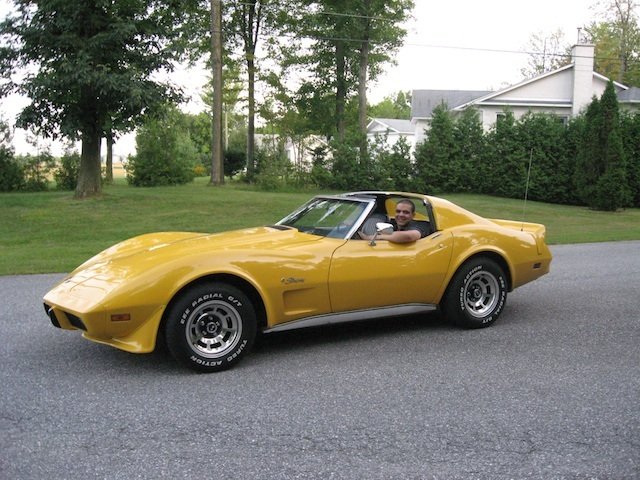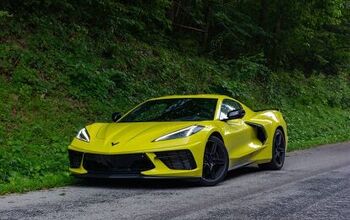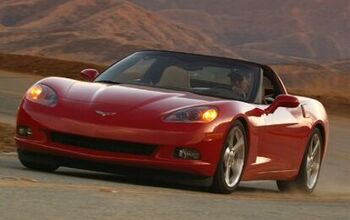Review: 1976 Chevrolet Corvette

For accountants, there are two certainties: golf and taxes. Together, both are tedious enough to make me want death. Unfortunately, I knew I’d be hearing a lot about both of these moribund subjects at our firm golf tournament. I was in the parking lot that morning, praying to the heavens for divine intervention when I heard my boss’ 1976 Corvette growling and lazily pulling up. As soon as I saw the ‘Vette, I decided to cash in the goodwill I’d earned by working 300 hours of overtime between November and March. “Fifteen minutes – no more,” he said. Score.
As we sat down for the drive, my boss smiled. He knew what was coming. I turned the ignition; the car sputtered lamely. “This always happens when I drive cars that are older than me,” I said. I primed it with a flick of the gas and the 305 V8 rumbled to life. T-Top off, we hit the country roads near the course.
The car’s age was immediately apparent. The brakes were spongy and non-linear, the pedal travel was maddening and the stock automatic only had three speeds. The car’s handling managed to somehow both be soft, yet twitchy over destitute farm roads. By far the worst thing was the skinny steering wheel. Though it was relatively linear, the steering offered about 20 degrees of play before engaging in earnest, and when it did, it gave me an upper body workout worthy of P90X. Gripping the skinny tiller, and then making the Herculean effort to rotate it, I wondered if power steering should trump sliced bread as the world’s greatest invention.
I struggled to find a basis for comparison. The Corvette was so raw, so unrefined, so different from anything I’d driven. Though it was a “luxury” car in its day, I could never treat it as such. Every change of direction had to be planned in advance, lest the understeer or snap oversteer take over with such non-linear brakes. Every turn of the steering required a rest until the next. This thing wasn’t even close to a luxury car, it was a motorcycle on four wheels. Even the straight pipes and their thunderous burble reminded me of a bike.
As we bombed it down the country roads, I wasn’t taken back to a scene from Bullit, or 2 Fast Too Furious. The only thing I could think of was the opening scene in Lawrence of Arabia. The one where Peter O’Toole pushes his bike to the limit, swallowing the country road ahead of him, approaching death so closely just to see if he could still feel alive.
“This is all really cheesy,” I said to my boss. “Yeah, but it’s a kind of cheesy I like,” he replied.
It all felt so ancient, belonging to a time when Americans loved the open road. Before drivers learned to delegate 90 percent of a car’s decisions to a computer. A time when cars were so fun, and new, and cool, and awesome that just hitting a piece of strip was an event in and of itself. And the Stingtay was near the top of the pantheon, as far as perfect cars to devour the Interstate: more adventurous and accessible than a Cadillac of the same vintage, and more athletic than a Chevy Impala.
As cars became more insular, and the “Sunday drive” became a thing of the past, they stopped making Vettes like this one. But this Vette didn’t just take me through country roads, it brought me back to 1976. The 305 burbled, the sun shone and the road lay ahead of us. No speed traps, no ABS, no traction control. Just the Vette, my scared shitless Boss and I. A rare moment of automotive nirvana.
In the end, it didn’t really matter that the 305 could barely manage to produce wheelspin without power braking. And I hardly cared that the yellow Stinger was ridiculously phallic (it could probably arouse Bob Dole from the dead). Or that the seats were so old and cracked and offered so little lumbar support that I regretted not bringing my chiro along. Nope, none of that mattered.
Not having been alive when it rolled off the line, it was clear I couldn’t evaluate the Vette against its peers. All I knew was that I loved it. Was it because it was so different than the type of cars I grew up in, or was it because it was a bona fide good car? Out here on these country roads, as the miles piled up, the engine roared and I felt strangely at peace with myself, I’m not sure the answer really mattered.

Latest Car Reviews
Read moreLatest Product Reviews
Read moreRecent Comments
- Analoggrotto I don't see a red car here, how blazing stupid are you people?
- Redapple2 Love the wheels
- Redapple2 Good luck to them. They used to make great cars. 510. 240Z, Sentra SE-R. Maxima. Frontier.
- Joe65688619 Under Ghosn they went through the same short-term bottom-line thinking that GM did in the 80s/90s, and they have not recovered say, to their heyday in the 50s and 60s in terms of market share and innovation. Poor design decisions (a CVT in their front-wheel drive "4-Door Sports Car", model overlap in a poorly performing segment (they never needed the Altima AND the Maxima...what they needed was one vehicle with different drivetrain, including hybrid, to compete with the Accord/Camry, and decontenting their vehicles: My 2012 QX56 (I know, not a Nissan, but the same holds for the Armada) had power rear windows in the cargo area that could vent, a glass hatch on the back door that could be opened separate from the whole liftgate (in such a tall vehicle, kinda essential if you have it in a garage and want to load the trunk without having to open the garage door to make room for the lift gate), a nice driver's side folding armrest, and a few other quality-of-life details absent from my 2018 QX80. In a competitive market this attention to detai is can be the differentiator that sell cars. Now they are caught in the middle of the market, competing more with Hyundai and Kia and selling discounted vehicles near the same price points, but losing money on them. They invested also invested a lot in niche platforms. The Leaf was one of the first full EVs, but never really evolved. They misjudged the market - luxury EVs are selling, small budget models not so much. Variable compression engines offering little in terms of real-world power or tech, let a lot of complexity that is leading to higher failure rates. Aside from the Z and GT-R (low volume models), not much forced induction (whether your a fan or not, look at what Honda did with the CR-V and Acura RDX - same chassis, slap a turbo on it, make it nicer inside, and now you can sell it as a semi-premium brand with higher markup). That said, I do believe they retain the technical and engineering capability to do far better. About time management realized they need to make smarter investments and understand their markets better.
- Kwik_Shift_Pro4X Off-road fluff on vehicles that should not be off road needs to die.


































Comments
Join the conversation
Check this out, for people that think the 76 is the least desirable year, Found this on CorvetteBlogger.com. BTW, I love my 76, the last Stingray! Top Appreciation Models 2009 Year Make % Change Average Price 1976 T-Top 10% $10,800 1962 Roadster 9% $52,700 1963 Coupe 9% $54,500 1977 T-Top 9% $12,000 1957 Roadster 8% $64,800 1965 Roadster 8% $46,100 1960 Roadster 7% $50,400 1963 Roadster 7% $41,600 1964 Roadster 7% $38,200 1966 Coupe 7% $46,200 Quite surprisingly, we found the 1976 Corvette at the top of our appreciation chart at 10% followed by the 1977 model at 9%. Evidently what we are seeing is renewed interest in the last of the traditional C3 body style models prior to the C3 change to a ‘fast back’ body style with the 1978-1982 models. It is also interesting to note the 1976 and 1977 T-Tops are selling at approximately $10-$12,000 LESS than the C3 chrome bumper Corvettes with the same body silhouette.
Bought one of these new. If I remember correctly I paid $10,680. 4 speed with the T-Bar roof. So it would now be worth about the same which is a lot more than I can say for the Dodge Caravans I have been driving for the past 20 years. At the time the '76 was considered superior to the 73, 74 and 75 models. I certainly had no trouble with those if they were unmodified. For its time it was considered fast and had far more status (and sex appeal) that any European car, except for Aston Martins. However, the rear defog button was located down in the tunnel, the seats were awful, the car squeeked and it blew hot air constantly. Since it didn't have A.C. when it rained in the hot weather it was basically undriveaable due to the heat in the driver's compartment. The battery was behind the seats. Mine died once. As a safety feature the clutch had to be depressed to start the car. So I had to lay across the seats and work the clutch, gas, brake (my emergency brake was defective from the factory) with my hands while the seats were lowered over my back and the booster was run to the battery. Still, great times. Wish that I still had it. Unfortunately needed something more 'practical' so I traded it for a realy P.O.S. brand new '78 T-Bird.